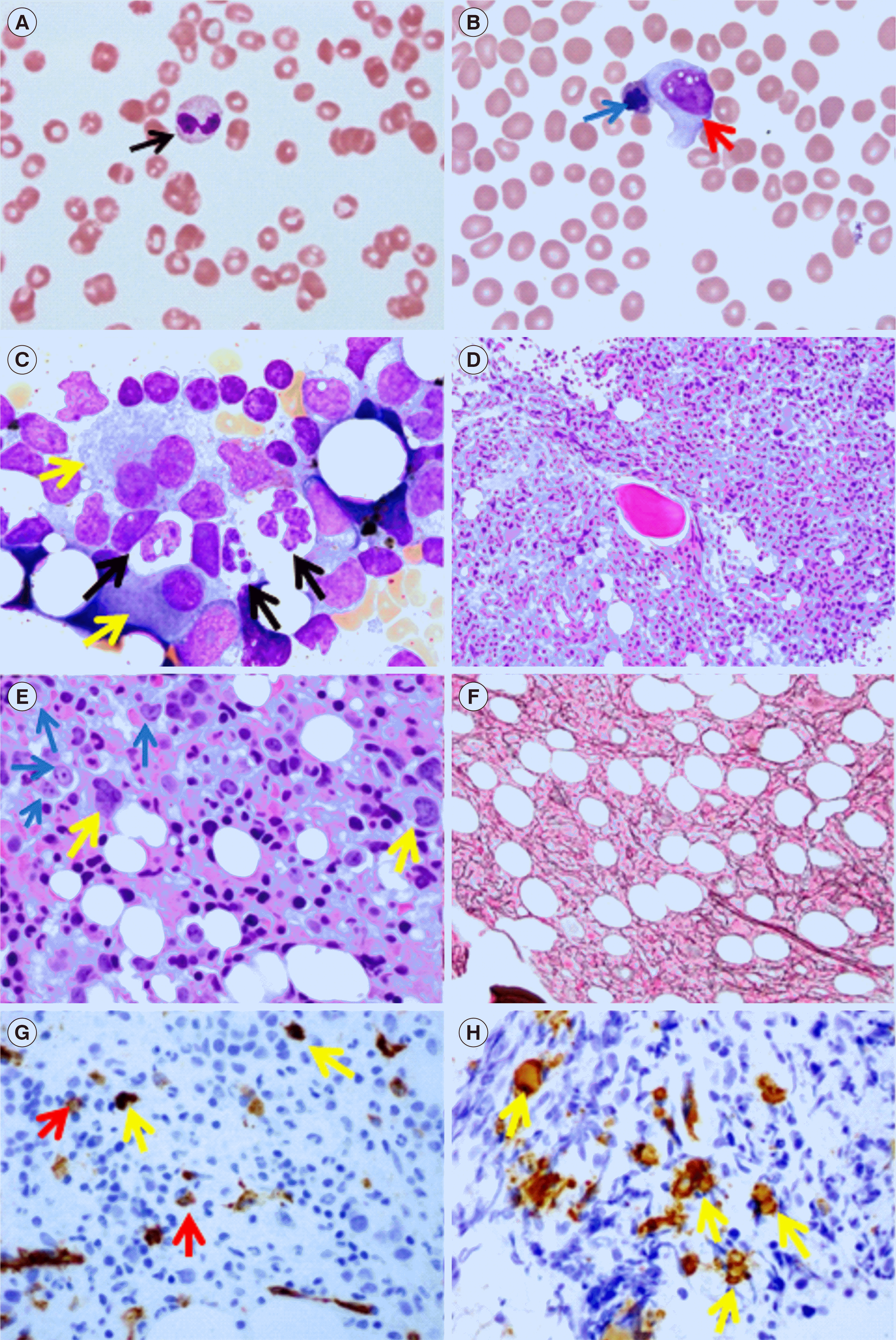1. Kuter DJ, Bain B, Mufti G, Bagg A, Hasserjian RP. 2007; Bone marrow fibrosis: pathophysiology and clinical significance of increased bone marrow stromal fibres. Br J Haematol. 139:351–62. DOI:
10.1111/j.1365-2141.2007.06807.x. PMID:
17910625.

2. Gömöri G. 1937; Silver impregnation of reticulum in paraffin sections. Am J Pathol. 13:993–1002.5. PMID:
19970363. PMCID:
PMC1911151.
3. Kvasnicka HM, Thiele J, Schmitt-Graeff A, Diehl V, Zankovich R, Niederle N, et al. 2001; Bone marrow features improve prognostic efficiency in multivariate risk classification of chronic-phase Ph1+ chronic myelogenous leukemia: a multicenter trial. J Clin Oncol. 19:2994–3009. DOI:
10.1200/JCO.2001.19.12.2994. PMID:
11408494.

4. Subramanian R, Basu D, Dutta TK. 2007; Significance of bone marrow fibrosis in multiple myeloma. Pathology. 39:512–5. DOI:
10.1080/00313020701570038. PMID:
17886102.

5. Vener C, Fracchiolla NS, Gianelli U, Calori R, Radaelli F, Iurlo A, et al. 2008; Prognostic implications of the European consensus for grading of bone marrow fibrosis in chronic idiopathic myelofibrosis. Blood. 111:1862–5. DOI:
10.1182/blood-2007-09-112953. PMID:
18029552.

6. Campbell PJ, Bareford D, Erber WN, Wilkins BS, Wright P, Buck G, et al. 2009; Reticulin accumulation in essential thrombocythemia: prognostic significance and relationship to therapy. J Clin Oncol. 27:2991–9. DOI:
10.1200/JCO.2008.20.3174. PMID:
19364963. PMCID:
PMC3398138.

8. Arber DA, Orazi A, Hasserjian R, Thiele J, Borowitz MJ, Le Beau MM, et al. 2016; The 2016 revision to the World Health Organization classification of myeloid neoplasms and acute leukemia. Blood. 127:2391–405. DOI:
10.1182/blood-2016-03-643544. PMID:
27069254.

9. Pagliuca A, Layton DM, Manoharan A, Gordon S, Green PJ, Mufti GJ. 1989; Myelofibrosis in primary myelodysplastic syndromes: a clinico-morphological study of 10 cases. Br J Haematol. 71:499–504. DOI:
10.1111/j.1365-2141.1989.tb06309.x. PMID:
2640542.

10. Della Porta MG, Malcovati L, Boveri E, Travaglino E, Pietra D, Pascutto C, et al. 2009; Clinical relevance of bone marrow fibrosis and CD34-positive cell clusters in primary myelodysplastic syndromes. J Clin Oncol. 27:754–62. DOI:
10.1200/JCO.2008.18.2246. PMID:
19103730.

11. Buesche G, Teoman H, Wilczak W, Ganser A, Hecker H, Wilkens L, et al. 2008; Marrow fibrosis predicts early fatal marrow failure in patients with myelodysplastic syndromes. Leukemia. 22:313–22. DOI:
10.1038/sj.leu.2405030. PMID:
18033321.

12. Fu B, Jaso JM, Sargent RL, Goswami M, Verstovsek S, Medeiros LJ, et al. 2014; Bone marrow fibrosis in patients with primary myelodysplastic syndromes has prognostic value using current therapies and new risk stratification systems. Mod Pathol. 27:681–9. DOI:
10.1038/modpathol.2013.187. PMID:
24186132.

13. Lambertenghi-Deliliers G, Orazi A, Luksch R, Annaloro C, Soligo D. 1991; Myelodysplastic syndrome with increased marrow fibrosis: a distinct clinico-pathological entity. Br J Haematol. 78:161–6. DOI:
10.1111/j.1365-2141.1991.tb04411.x. PMID:
1712222.

14. Greenberg PL, Tuechler H, Schanz J, Sanz G, Garcia-Manero G, Solé F, et al. 2012; Revised international prognostic scoring system for myelodysplastic syndromes. Blood. 120:2454–65. DOI:
10.1182/blood-2012-03-420489. PMID:
22740453. PMCID:
PMC4425443.

15. Vardiman JW, Thiele J, Arber DA, Brunning RD, Borowitz MJ, Porwit A, et al. 2009; The 2008 revision of the World Health Organization (WHO) classification of myeloid neoplasms and acute leukemia: rationale and important changes. Blood. 114:937–51. DOI:
10.1182/blood-2009-03-209262. PMID:
19357394.

16. Verhoef GE, De Wolf-Peeters C, Ferrant A, Deprez S, Meeus P, Stul M, et al. 1991; Myelodysplastic syndromes with bone marrow fibrosis: a myelodysplastic disorder with proliferative features. Ann Hematol. 63:235–41. DOI:
10.1007/BF01698371. PMID:
1958747.

18. Kröger N, Zabelina T, van Biezen A, Brand R, Niederwieser D, Martino R, et al. 2011; Allogeneic stem cell transplantation for myelodysplastic syndromes with bone marrow fibrosis. Haematologica. 96:291–7. DOI:
10.3324/haematol.2010.031229. PMID:
20971823. PMCID:
PMC3031698.

21. Wang J, Wang Q, Zhang H, He Y, Huang Y, Zhang R, et al. 2021; Moderate to severe marrow fibrosis as a more advanced risk factor for MDS and MDS-AML patients with excess of blasts receiving allogeneic hematopoietic stem cell transplantation. Transplant Cell Ther. 27:666.e1–9. DOI:
10.1016/j.jtct.2021.05.006. PMID:
34020086.

23. Thiele J, Kvasnicka HM, Facchetti F, Franco V, van der Walt J, Orazi A. 2005; European consensus on grading bone marrow fibrosis and assessment of cellularity. Haematologica. 90:1128–32. PMID:
16079113.
24. Fu B, Ok CY, Goswami M, Xei W, Jaso JM, Muzzafar T, et al. 2013; The clinical importance of moderate/severe bone marrow fibrosis in patients with therapy-related myelodysplastic syndromes. Ann Hematol. 92:1335–43. DOI:
10.1007/s00277-013-1776-3. PMID:
23660629. PMCID:
PMC4190057.

25. Melody M, Al Ali N, Zhang L, Ramadan H, Padron E, Sallman D, et al. 2020; Decoding bone marrow fibrosis in myelodysplastic syndromes. Clin Lymphoma Myeloma Leuk. 20:324–8. DOI:
10.1016/j.clml.2020.01.003. PMID:
32044274.

26. Ramos F, Robledo C, Izquierdo-García FM, Suárez-Vilela D, Benito R, Fuertes M, et al. 2016; Bone marrow fibrosis in myelodysplastic syndromes: a prospective evaluation including mutational analysis. Oncotarget. 7:30492–503. DOI:
10.18632/oncotarget.9026. PMID:
27127180. PMCID:
PMC5058695.

27. Marisavljević D, Rolović Z, Cemerikić V, Bosković D, Colović M. 2004; Myelofibrosis in primary myelodysplastic syndromes: clinical and biological significance. Med Oncol. 21:325–31. DOI:
10.1385/MO:21:4:325. PMID:
15579916.

29. Allen EF, Lunde JH, McNally R, Branda RE. 1996; A case of acute myelofibrosis with complex karyotypic changes: a type of myelodysplastic syndrome. Cancer Genet Cytogenet. 90:24–8. DOI:
10.1016/0165-4608(96)00037-4. PMID:
8780742.

32. Maschek H, Georgii A, Kaloutsi V, Werner M, Bandecar K, Kressel MG, et al. 1992; Myelofibrosis in primary myelodysplastic syndromes: a retrospective study of 352 patients. Eur J Haematol. 48:208–14. DOI:
10.1111/j.1600-0609.1992.tb01587.x. PMID:
1592101.
33. Hussein K, Stucki-Koch A, Kreipe H. 2018; Profile of fibrosis-related gene transcripts and megakaryocytic changes in the bone marrow of myelodysplastic syndromes with fibrosis. Ann Hematol. 97:2099–106. DOI:
10.1007/s00277-018-3411-9. PMID:
29961094.

34. Scott BL, Storer BE, Greene JE, Hackman RC, Appelbaum FR, Deeg HJ. 2007; Marrow fibrosis as a risk factor for posttransplantation outcome in patients with advanced myelodysplastic syndrome or acute myeloid leukemia with multilineage dysplasia. Biol Blood Marrow Transplant. 13:345–54. DOI:
10.1016/j.bbmt.2006.10.030. PMID:
17317588.

35. Wang N, Xu H, Li Q, Fang X, Liu J, Sui X, et al. 2020; Patients of myelodysplastic syndrome with mild/moderate myelofibrosis and a monosomal karyotype are independently associated with an adverse prognosis: long-term follow-up data. Cancer Manag Res. 12:5881–91. DOI:
10.2147/CMAR.S258875. PMID:
32765089. PMCID:
PMC7371562.





 PDF
PDF Citation
Citation Print
Print



 XML Download
XML Download